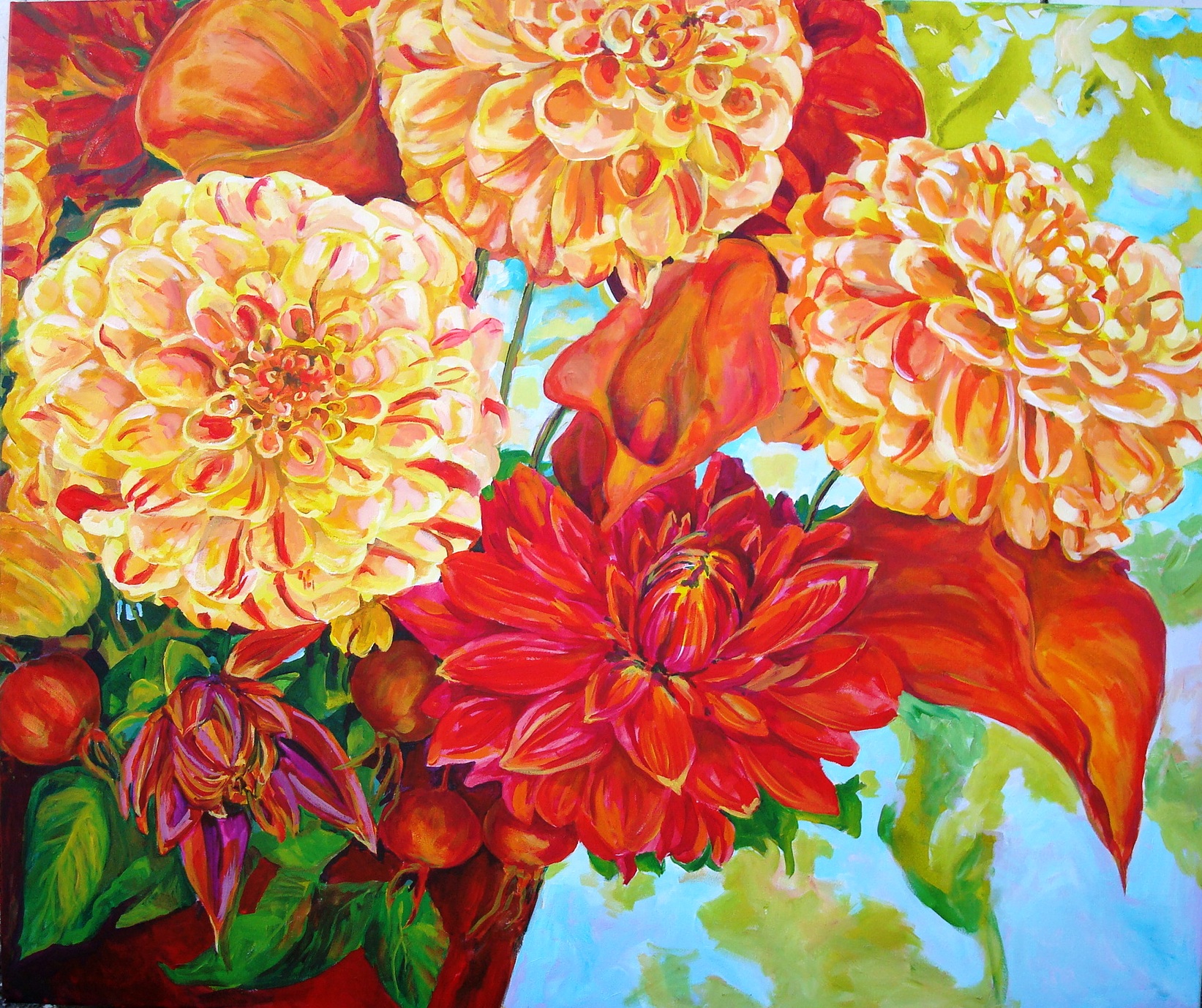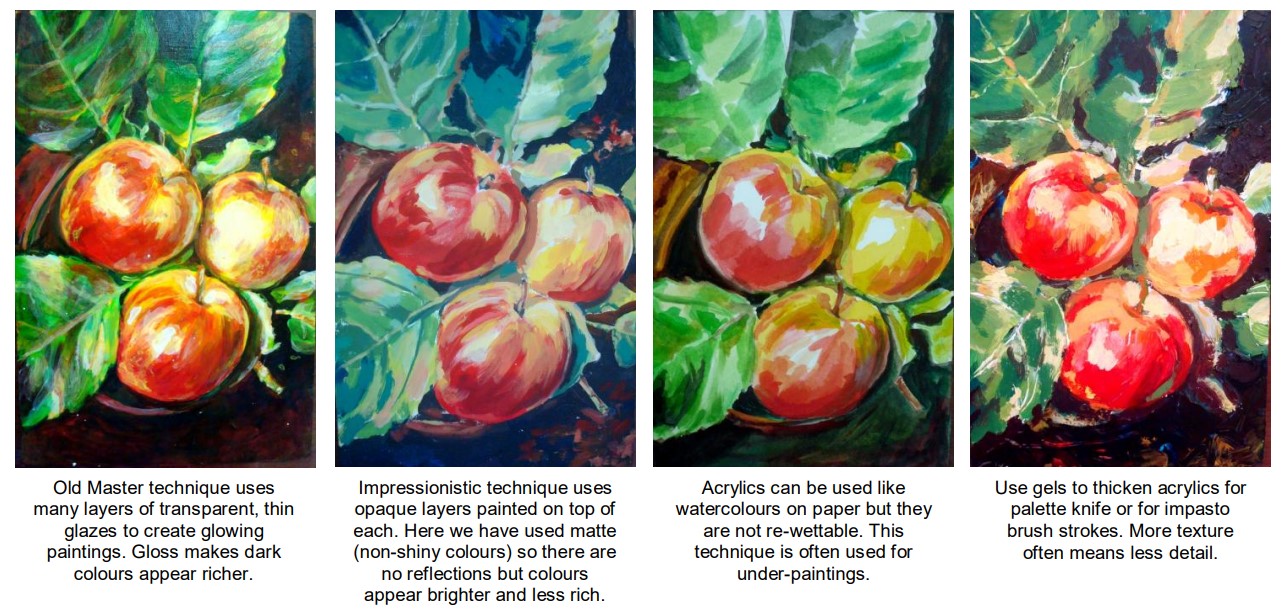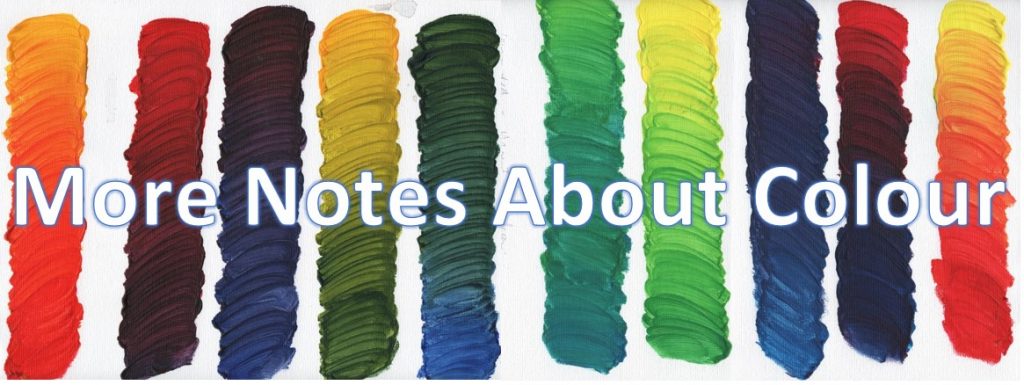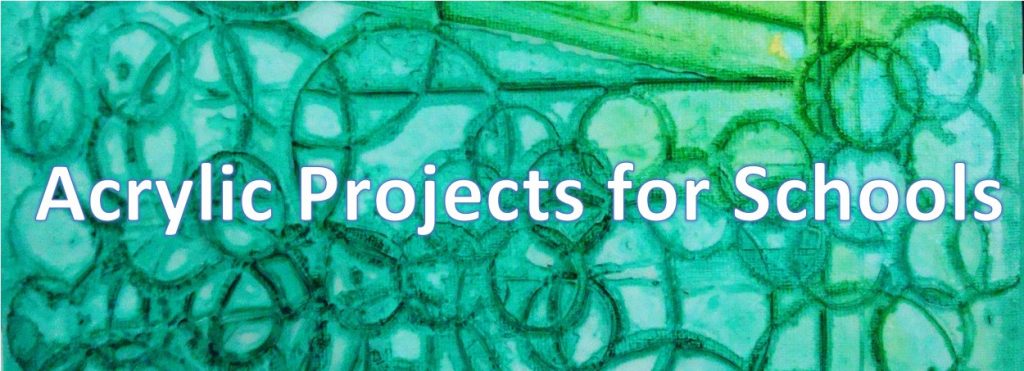Welcome to the world of acrylics. Every medium has its strengths and weaknesses and we strive to unlock some of the mysteries of acrylic painting and help you maximize the use of the medium.
10 Frequently Asked Questions About Acrylics

1. Why choose acrylics?
The best reason to choose any painting medium is that you have an affinity for it: you have seen it at work, admire it, and want to use it. Acrylic paint is remarkably diverse in its applications and results. Because there are so many surfaces on which you can work, so many effects you can get, and so many methods you can try, acrylic paint is a great choice for the artist who likes to explore and experiment.
2. What is acrylic paint?
First marketed in the 1950s, acrylic paints continue to be popular because they are adaptable, convenient, and economical. Technically, these water-soluble paints are pigment in acrylic polymer emulsion— in other words, plastic! They are different in composition from either oil paint or watercolour, and have their own properties. Acrylics are notably fast-drying, permanent, and versatile. Acrylic paint cleans up easily with water because it’s a water-based medium. Like watercolour, water can be added to thin it, and it dries fast. Unlike watercolour, acrylic paint can be mixed with a wide range of specially created mediums to remarkable effect.
3. Are acrylics difficult?
An often-expressed opinion says that acrylics are the easiest of the three major painting mediums (acrylics, oils, watercolours). Acrylic paint is more flexible than oil paint. A real strength is an option to paint on a wide range of supports, including raw canvas. In fact, acrylic doesn’t need a support – use it on a plastic surface and peel it off when it is dry. An acrylic painter need not observe the same strict painting practices as other painters and can experiment in a number of ways not open to watercolourists or oil painters. The difficulty of acrylic paint may simply lie in making the best use of the paint itself.
4. Are acrylics expensive?
As with other paints, the student grade of acrylics is less expensive than the professional grade – and has less pure pigment, thereby making for less vibrantly coloured paintings. Also, some pigments, like cadmium, are expensive, but closely matched substitutions are available. Without mediums, acrylic paints are less exciting to use. Mediums extend the paint, as does water, but with a variety of desirable results that differ considerably from water’s simple thinning of the paint. Therefore, you will want to consider adding the cost of some mediums to the cost of paints. Acrylic paint sets are a great way to get started without breaking the budget and colours are selected to work together.
5. Aside from paint, what do you need to make an acrylic painting?
Feel free to paint on canvas, primed or raw, stretched or unstretched; on other fabric; on wood panels, rock and found objects, on almost anything. You can use brushes, with synthetic fibers or palette knives, or fingers, or pour the paint on – versatility is the hallmark of acrylic painting.
Brushes
If you are painting with acrylics on canvas or board, for example, you will most likely want to acquire a range of brushes. We can show you a range of brushes from small to large in flat or round shapes. If painting detail is important to you, choose the smaller sizes. For broad expressive strokes, use large brushes. We would be happy to explain what the other shapes will do for you, such as filberts and brights. Read our post to gain a basic understanding of which brushes do what.
Why synthetic brushes?
We have a preference for synthetic brushes. Rejuvenated a bent tip by dipping it in boiling water. This will not help if it has a paint build-up in it. Windex will remove dried paint from brushes. Another advantage is their long life and durability. There are other tools to consider, too, such as various blades and wedges in silicon, metal, or plastic. Serrated edges, angled blades, and other such shapes are well worth considering for the range of marks they will make. Try moving two colours into one another with a spatula shape, or combing one colour over another with a serrated palette knife.
Easels
We have many types of easels to choose from, depending on your needs. The most economical is a tabletop easel, used to paint while sitting. For the home studio, and for working on larger pieces, consider a floor easel. These are available in many sizes and prices. If you need an easel for classes or painting outdoors, portable easels are available, too.
Consider paint grades and properties
Holbein is a professional-grade product, available at a reasonable price. Holbein makes thick-bodied, high-viscosity acrylic and liquid acrylic, as well as acrylic inks. acrylic mediums, gels, additives, and gessos. Talens makes a student-grade acrylic called Amsterdam Standard. Chromacryl is a standard acrylic for schools. Golden is our top line, with heavy body, liquid, and Open lines (‘Open’ are slower drying). Like Holbein, Golden offers a very wide range of gels, mediums, and additives for you to explore.
6. How important are mediums to acrylic painting?
Mediums for acrylic paints range from those that thin the paint, making it more like watercolour, to those that thicken it to oil-paint consistency, as well as those that texturize the paint so that it resembles plaster or that modify the colour. Some add gloss, and others matte the paint. Each acrylic paint company has at least one, and sometimes a great many, mediums, each with a special purpose. Aside from their use with acrylic paints
some mediums, such as gels, are used in image transfers, to thicken paint for impasto effects and in multimedia projects. You are not exploring acrylic paint if you are not exploring mediums.
Several quick distinguishing points about acrylic paint:
- Different brands of acrylics can be matte, semi-gloss, or gloss. Mixing the mediums you choose can change the finish as well.
- Fluid acrylics more obviously resemble watercolours, and heavy-body acrylics resemble oils. Like watercolour, either can be thinned with water (never more than 50%). Unlike watercolour, they do not rewet. Like oil paint, both can be made thick, juicy, and impasto, or layered in fine glazes. Unlike oil paint, they dry quickly and will not yellow with age.
- Tools used for acrylic application include brushes, palette knives, and silicon blades, and wedges. Let your creativity blossom; sponge, pour, drip, and throw acrylics. Airbrushes are also available.
- Dry acrylic paint is flexible. Create acrylic ‘skins’ by pouring or layering paint onto an appropriate surface and removing it when it’s dry. Plastic is the obvious choice. Try shaping or carving skins.
- An ever-growing number of mediums, including fluids, pastes, and gels, modify their behaviour and appearance. The key to getting acrylic paint to perform at its utmost capability is mediums and gels.
- Use acrylic mediums and gels independently of paint. Try embedding or impressing objects into gels. opening up to a myriad of project possibilities. Print textures, create strings of paint, make mounds of it, make skins of it – have fun with it! It’s worthwhile to research the many possibilities of acrylic paint. Take a short introductory class to jumpstart your understanding. Learning to use acrylic mediums will only enhance your painting experience and lead to new discoveries.
- Acrylic paint is great for mixed media projects. Try using charcoal, pastel, or ink, applied over or under the paint. Use any number of materials, including sand, glitter, and other objects.
- Acrylic is used in printing and writing inks, gouache, markers, and spray paint, all of which have similar properties to acrylic paint.
7. Are there any drawbacks to acrylics?
Acrylic paints cannot carry the same pigment load as oil paint, and some painters prefer oils for that reason. Acrylic paint dries quickly. Thin applications dry in minutes and are difficult to remove Thicker applications will dry to the touch in 1 – 3 hours and will become tough and permanent after about a month. A retarder is an additive you can use to slow the drying process. Other ways of extending the palette time (open time) of your acrylics during use are by adding a retarder or Golden Acrylic Glazing Liquid, or by spraying your work and palette with a mist of water. The Golden Open Acrylic line stays workable for longer than other acrylics, and is a soft, blendable paint, making it desirable for some styles of painting to which regular acrylic is not suited. A humidified room will also help them dry more slowly.
8. How versatile are acrylic paints?
Acrylic paint is so versatile you can do more than paint with it. You can sculpt with it, cut it and shape it. It is durable. Use acrylics on canvas, wood, and paper painting (with or without acrylic gesso). Decorative art, airbrushing, screen printing, and fabric painting are possible – almost any non-greasy or degreased surface will take acrylic paint. Mixed media works can benefit from the use of acrylic paints and mediums. Artists are able to customize the appearance and working properties of acrylic colour by adding gels or mediums. Shine levels can range from matte, satin or gloss. The texture of paint can be water-thin to thick-impasto (and everything in between). Transparent or opaque is another option. Drying times are malleable to some degree. As you can see, acrylics go well beyond mimicking oil and watercolour: they offer a distinct, enormously versatile means of creating visual art.

Although acrylics can be used straight from the container or thinned with water, mediums are invaluable in exploiting the versatility of acrylic paint. Moreover, they will keep the paint film strong and lustrous, where water can tend to weaken it. Add gels and mediums to artist colours to make a larger volume of paint
9. Colour Mixing
Beginning painters should feel free to experiment with their colours and their paint. In colour mixing, there are three primary colours; red, yellow, and blue, which you blend to obtain many other colours including purple, orange, green, and a nice range of browns, greys, and blacks. For example, try Crimson Red with a touch of Ultramarine Blue and see the glorious purples they make. Or try Azo Red and Phthalo Blue for a more subdued purple. For some brilliant greens, use a pinch of Phthalo Blue with Hansa Yellow. Other similar primaries will give you variations on green. A suggested palette of about 12 colours can be used to mix, to produce virtually any colour you desire. A colour wheel is a handy way to look at what combinations to try. For more information, colour mixing guides are available in our book department.

10. Should acrylic paintings be varnished?
After an acrylic painting is thoroughly dry, let’s say six months from completion, you can apply a removable varnish to give the surface coherence and protect it from dust and dirt. Many painters question the need for varnishing and acrylic painting because they mistakenly think of a very glossy finish; varnish, however, can be matte or semi-gloss as well as gloss. It is a matter of preference.
Workshops:
To learn more about the versatility of acrylics, we recommend you attend one of our introductory workshops. Hands-on experience, as provided by our knowledgeable instructors, is great for learning about the unique ways you can use acrylics. We hold other workshops on different specific topics such as painting with light and colour, abstract acrylic painting, and mixed-media collaging, the last of which makes use of many acrylic products, including paints, mediums, and gels. Check our workshop schedule and register early.
_________________________
Kim Fjordbotten (June 2020) As the owner of The Paint Spot, Kim Fjordbotten is passionate about helping artists use materials and make art. She is available as a speaker and educator for teachers and art associations. The Paint Spot offers exhibitions, workshops, and beautiful art materials to inspire your creativity.
Notice you are not bombarded with advertising while sourcing this information. Please help us by purchasing your art supplies from The Paint Spot. We really appreciate your business and it means we can keep making educational posts for free. Thank you.



